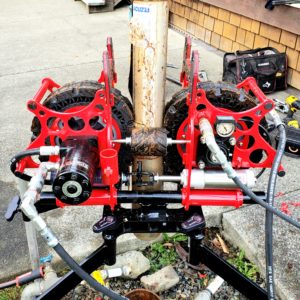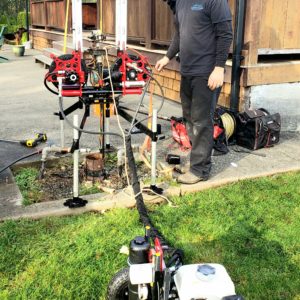What is a true well flow rate or capacity test?
 A true well flow test, well recovery test, or well draw-down test requires special equipment and locating, opening, and pumping right at the well. That procedure has the advantage that the well flow rate recorded is not affected by other problems such as a piping error or clogged water pipes or a defective well pump or water pressure tank. Testing is performed right at the well head and requires a specialized process and equipment.
A true well flow test, well recovery test, or well draw-down test requires special equipment and locating, opening, and pumping right at the well. That procedure has the advantage that the well flow rate recorded is not affected by other problems such as a piping error or clogged water pipes or a defective well pump or water pressure tank. Testing is performed right at the well head and requires a specialized process and equipment.
When buying a property it’s reasonable to perform a water flow test right in the building, so long as you keep in mind that the water pump, water tank, pump controls, and the condition of the water supply piping, the height of the building, and the condition of the fixtures (such as a clogged sink spigot strainer) are all affecting the actual flow rate you see at a fixture. What we describe below is not a true well flow test or well drawdown test but this procedure can let us know early if there is an obvious red flag alert about water quantity. Providing volume tests us very important for example if you are purchasing a home and the current owner states they have never had any water shortages however they live with just one or two people and the new occupants may have 6 or more residents, this may give a false indication and or security on the wells capacity.
Vortech provides many water volume and flow tests for both residential and commercial clients on Vancouver Island. This is a speciality industry that requires knowledge and the appropriate equipment to assure testing is done correctly.
Commercial well testing, Industrial well testing, residential well testing. Well volume testing.
How Water Flow & Pressure Behave in a Building
The water flow rate at a building served by a pump and well will vary over time as the pump cycles on and off, and perhaps slow down or even stop completely if the well and its static head have only a limited volume of water available. The water pressure at a fixture served by a private well, pump, and pressure tank, will normally vary between the pump cut-in pressure (typically 20 psi or 30 psi) and the pump cut out pressure (typically 40 psi to 50 psi or a little higher).
If water pressure is always “ok” but varies between pretty strong and not so strong, this might be normal. Because the water pressure normally varies within this range, you may observe a modest change in water flow at an individual fixture such as a shower head or sink faucet.
If water pressure starts very strong and falls off to much slower immediately, we suspect a problem with clogged piping in the building: if the inside of a water supply pipe is blocked by mineral deposits or rust the effective diameter of the pipe is reduced, causing a reduction in water flow rate in a building even if the starting water pressure is good. Lots of people are confused about the difference between water flow rate (how many gallons per minute are coming out of a faucet) and water pressure (how hard is the water pressing inside the pipes and fixtures).
If water pressure drops way down to a very slow rate or stops entirely, there is a problem with the water pump, tank, piping, pump controls, or worst, there may be a problem with the well itself.
What is a Reasonable Water Flow Rate in a Building?
Subjectively, we should be able to go to the highest bathroom or other plumbing facility in the building and run two fixtures simultaneously, seeing a reasonable water flow in which one could shower or wash. If you turn on the top floor shower and then open a sink faucet and you see the shower slow to a trickle, the building water pressure is unacceptable. If you couldn’t reasonably bathe in a trickling shower flow, the flow is not functional. This usually not a water quantity problem, it’s a pump, water tank, piping, or fixture problem. Usually. A well with a bad flow rate can also show up as a poor in-building water flow rate.
A typical bath sink faucet will flow around 1 gpm to 2 gpm, bath tub spout will flow at around 2.5 to 5 gpm, and a kitchen sink faucet at around 2-3 gpm. Low-flow water-saving fixtures may provide a good strong water stream but fewer gallons per minute.
Because a true well flow test or well water draw down test requires that a special pump be attached directly to the well, this test is not normally performed during a pre-purchase home inspection or when a new well has been drilled.. But this test should absolutely be performed if the inspection, building history, or other clues suggest that there may be a water quantity problem at the property.
Visual Clues Can Suggest that the Water Well Has Limited Capacity
Look around for other clues about water quantity: if you see lots of bottles of water stored near the water pump or water tank or even elsewhere in the building, if you see that flow restrictors are in use at every fixture, if you see a one line jet pump, any of these might be a clue that the well is unreliable or of limited capacity. Look for:
- • Collections of water bottles stored by the water pump, presumably to re-prime the pump when water pressure is lost
- • Large family of occupants including small children, with no dishwasher or no clothes washer installed
- • Seller or realtor requests early termination of a well flow test or septic loading and dye test
- • Presence of old abandoned pumps, pump parts, etc.
- • Suggestions to rely on amateur or un-documented “well flow” tests that may not have been properly performed
Why is simple measurement water flow at a faucet an inaccurate test of well yield?
What about testing water flow and pressure from a well by using a flow gauge attached to a faucet? This is a “for show” measurement, not a real one – it is simply very inaccurate.
We can pretend to “measure” water flow, say at a tub spout, simply by seeing how many minutes it takes to fill the 5-gallon bucket. We can also pretend to “measure” water flow by attaching a flow meter gauge to a building faucet, typically to an outdoor spigot.
These tests are interesting but they’re just pretending to measure the well – they’re not really looking at the capacity of the well to deliver water. Instead this approach is really checking the capacity of the pump and piping to deliver a particular water flow rate and pressure
Lots of people do it, but we do not like nor trust most quantitative measurements of water flow at building fixtures because giving any quantitative number to such a flow is inaccurate. The flow at a plumbing fixture is set by the fixture itself, strainer, faucet, pipe diameter, pipe clogs, and by building piping and pump and water tank.
Furthermore, while we’re running fixtures at a modest rate, the water pressure will cycle up and down between the pump cut-in and pump cut-out pressure. Since the actual water pressure is varying constantly, collecting and measuring the volume of water at a fixture during any short interval does not describe the full capability of the water supply system.
If the pump is not on we’re not taking water out of the well: If water is being run slowly in a building, or perhaps just at one modest-flow fixture, the well pump will “catch up” with the demand, pressurize the water pressure tank, and the pump will turn off. The air spring in the water pressure tank keeps the water flowing out of the tank, but we’re not taking any water out of the well during this part of the pump cycle.
When multiple building fixtures are running and we’re taking lots of water out of the system, the well pump will usually run continuously. IF the well pump is running continuously, AND if it is not changing the pressure in the water pressure tank, then all of the pump output is going to the building fixtures and the sum of flow at all of them is probably a reasonable guess at the flow-rate capacity of the water supply system – that is, the capability of the well pump to send up water. We’re still not checking the real capability of the well to deliver water – not until we connect a pump that is capable of pulling water out of the well faster than it flows into the well.
So we’re not always testing the well yield when we’re running the water – it depends on how fast we run the water and how long we run the water to determine if our test has even a slight chance of telling us about the actual well yield or well flow rate.
Flow Rate At a Fixture = (Time to fill the 5-gallon bucket in minutes) / 5 gallons
But faucet water flow rate is not the well flow rate – it’s the flow rate of the pump and piping in the building. Don’t let anyone fool you on this point. Even if we ran all building fixtures at once, kept the well pump running continuously, and measured all of the flows (to add them up) we still are only measuring what the pump is delivering, not how much water the well can provide.
Why do these pretend tests then? Because we might run out of water early – showing that there is indeed a well capacity or water quantity problem.
Give Vortech a call to provide accurate well flow and volume testing.




 A true well flow test, well recovery test, or well draw-down test requires special equipment and locating, opening, and pumping right at the well. That procedure has the advantage that the well flow rate recorded is not affected by other problems such as a piping error or clogged water pipes or a defective well pump or water pressure tank. Testing is performed right at the well head and requires a specialized process and equipment.
A true well flow test, well recovery test, or well draw-down test requires special equipment and locating, opening, and pumping right at the well. That procedure has the advantage that the well flow rate recorded is not affected by other problems such as a piping error or clogged water pipes or a defective well pump or water pressure tank. Testing is performed right at the well head and requires a specialized process and equipment.